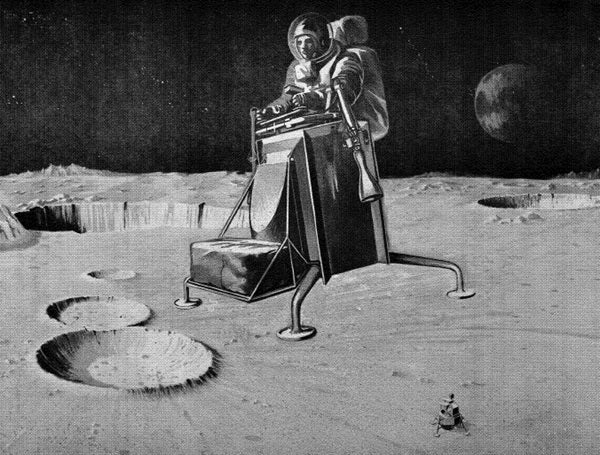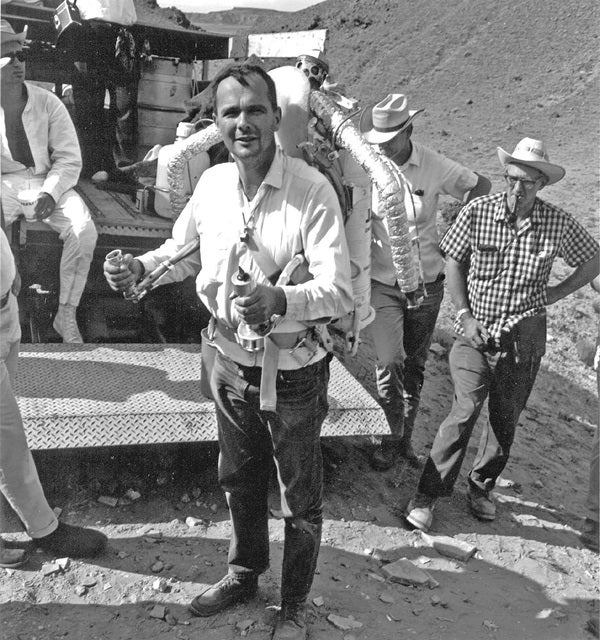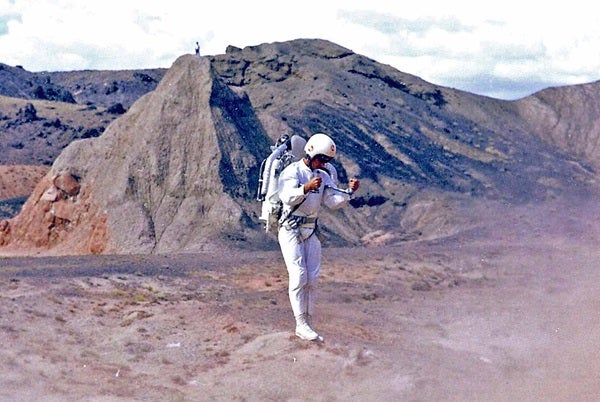Walking on the Moon is no small feat. Apollo spacesuits weighed about 180 pounds (82 kg), which essentially equaled the full body weight of the average astronaut. Even in the Moon’s lower gravity, exploring in these suits was hard work.
Even before Apollo 11’s successful landing, NASA was considering how astronauts on later missions could get around the Moon more efficiently. But before they planned to use lunar rovers, NASA was seriously considering using Lunar Flying Units, or LFUs, to jet the astronauts around.
How do you fly on the Moon?
In early 1969, NASA issued contracts to two competing groups to conduct seven-month studies exploring the feasibility of LFUs. The plan was to run the units on leftover fuel from Apollo’s landing craft, the Lunar Module (LM).
The contracts’ recipients were Bell Aerosystems Company and North American Rockwell, both of which had already done work for Apollo. Bell had designed the Lunar Landing Research Vehicle used to train astronauts to land safely on the Moon, as well as the LM’s ascent rocket, which carried astronauts back to the Command/Service Module (CSM) after surface exploration was complete. North American (which after a 1967 acquisition became North American Rockwell) had built the CSM, Apollo’s “mothership” responsible for carrying the crew to and from the Moon.
Both companies had also already dabbled in the idea of flying machines. By 1961, Bell had developed a “rocket belt,” which it originally marketed, unsuccessfully, to the U.S. Army (its 5 gallons (19 liters) of fuel only offered 20 seconds of flight time). And in 1964, North American Aviation had developed a proposal for a flying platform that allowed an astronaut to traverse the lunar surface while standing upright, carrying a payload of tools, samples, or even his crewmate on an attachable tray.
The final designs
For their 1969 Lunar Flying Vehicle (LFV), Bell expanded their rocket belt design into a platform, allowing it to carry more fuel. A standing astronaut controlled the vehicle’s two rocket nozzles — one on either side of the platform — with handles mimicking the controls in the LM, for which the astronauts had extensive training. The 235 pound (107 kg) platform could fly up to 70 mph (110 km/h) to distances up to 15 miles (24 km), maxing out about 75 feet (23 m) off the lunar surface.
North American Rockwell modified their standing platform design into an LFV with a seat for their 1969 model. From this flying chair, the astronaut controlled four engines attached beneath his seat. This provided redundancy the Bell system did not have — North American’s design could fly even if one engine failed simply by shutting off its complement and relying on the remaining two. But it also had a problem Bell didn’t have: the low-to-the-ground engines would kick up dust and debris during liftoff and landing, which could strike the astronaut, the LFV, or anything around them.
Their solution was to place a blanket beneath the LFV during takeoff. Carrying additional blankets would ensure that takeoff from more than one exploration site was possible. And during landing, the pilot was to simply cut the engines about 5 feet (1.5 m) above the surface, letting the vehicle drop safely the rest of the way in the low lunar gravity.
Its four engines could lift the 304 pound (138 kg) craft up to 2,000 feet (610 m), capable of potentially reaching hills or crater walls — provided they were within its distance limit of about 5 miles (8 km) from the LM.
What happened to the LFV?
NASA is well known for its redundancy. Flying was not the only way to potentially explore farther from the LM and in May 1969, a month before the deadline given to Bell and North American for their LFV designs, the agency announced its intention to also develop a Lunar Roving Vehicle (LRV) — a car astronauts could drive on the Moon.
While not as glamorous or perhaps even as space age-y, a stable, battery-powered, four-wheeled vehicle presented many advantages over the never-before-tried flying platforms reliant on leftover fuel. Just one month after the LFV design contracts were completed, NASA contracted Boeing to design and build its rover, shelving the LFV and ensuring that astronauts would leave tire tracks rather than liftoff and landing sites on the Moon.












